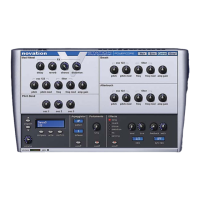Filter
Filter
The V-Station is an analogue subtractive type of music synthesizer. Subtractive implies that
part of the sound is subtracted or removed somewhere in the synthesis process.
The oscillators provide the raw waveforms many of which have plenty of harmonic content and
it is the filter that subtracts unwanted harmonics in a controllable manner.
The filter in the V-Station is a Low Pass type. A cut-off point is chosen and any harmonics
below that point are allowed to pass through unaffected and any above are filtered out. The
setting of the FREQUENCY knob on the V-Station panel dictates the point below which
harmonics are removed. This process of removing harmonics from the waveforms has the
effect of changing the sounds character or timbre. When the FREQUENCY knob is set fully
clockwise, the filter is set completely open and no harmonics are removed from the raw
oscillator waveforms:
Cutoff frequency
Here, all the harmonics pass through and the sound is very bright. However, as the control is
moved counter-clockwise, the cutoff frequency is reduced and the higher harmonics are
removed:
Cutoff frequency
In this example, all those harmonics within the shaded area pass through unaffected whilst
those above the cutoff frequency are removed and won’t be heard. With the cutoff set like this
(i.e. about halfway), the sound will have mellower tone. As the cutoff moves down, so more and
more upper harmonics will be removed.
In practice, there is a gradual reduction in the volume of the harmonics above the cut-off point.
How quickly these harmonics are reduced in volume above the cut-off frequency is determined
by the filter’s slope. This slope is measured in ‘volume units per octave’. Since Volume is
measured in decibels, this slope is quoted in the number of decibels per octave (dB/Octave).
Typical values are 12dB or 24dB per Octave. The higher the number, the faster the harmonics
are cut and the more pronounced the filtering effect.
12dB/Octave 24dB/Octave
Cutoff frequencyCutoff frequency
As you can see from the diagrams, the 12dB setting has a more gradual ‘slope’ than the 24dB
setting which is steeper and even though the CUTOFF is the same in both examples, more
upper harmonics are allowed to pass through with the 12dB setting than the 24dB setting.
Some say that 12dB/Octave filters are ‘fizzier’ whilst the 24dB/Octave setting sounds
‘punchier’ and more like the original analogue synths. The V-Station offers both types of filter
slopes to be selected.
14 Synthesis Tutorial

